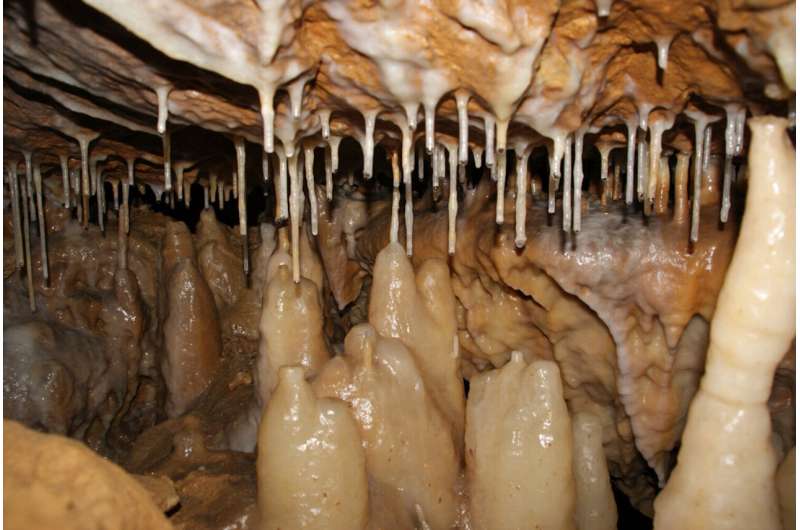This article has been reviewed according to Science X's editorial process and policies. Editors have highlighted the following attributes while ensuring the content's credibility:
fact-checked
peer-reviewed publication
trusted source
proofread
Researchers use stalagmite to reconstruct regional and global climate history

When combined with data from tree-ring records, stalagmites can open up a unique archive to study natural climate fluctuations across hundreds of years, a research team including geoscientists from Heidelberg University and the Karlsruhe Institute of Technology have demonstrated.
The researchers analyzed the isotopic composition of oxygen in a stalagmite formed from calcareous water in a cave in southern Germany. In conjunction with the data acquired from tree rings, they were able to reconstruct short-term climate fluctuations over centuries and correlate them with historically documented environmental events. The findings are published in the journal Earth and Planetary Science Letters.
Until now, short-term climate fluctuations over hundreds of years could be analyzed only by means of tree-ring records by combining independent measurements from a number of studies, explains geoscientist Dr. Tobias Kluge of the Karlsruhe Institute of Technology (KIT).
The size of the tree rings, which varies by a few millimeters, provides information on the dynamics of seasonal precipitation, in turn pointing to climatic conditions in the specific growth period. According to Dr. Kluge, summers with heavy rainfall are expected particularly in cold years, whereas very wet winters are expected in warm years.
In contrast to tree rings, stalagmites have only been used in exceptional cases to systematically measure climate data and their annual variations. The decisive factor is the rainwater infiltrating a cave, whose dissolved lime forms the stalagmites.
This water comes from local precipitation in the cold and warm seasons, and each is characterized by a special isotopic composition of oxygen. From this, analyses can be derived indicating whether and in which years winter or summer precipitation dominated.
The researchers from Heidelberg and Karlsruhe studied a stalagmite—a dripstone that grows upward from the floor of a cave—from the Kleine Teufelshöhle in Franconian Switzerland. With a growth rate of 1 to 4 centimeters per millennium, or an annual growth rate of about the width of a single hair, this stalagmite grew much more slowly than comparable ones.
The growth zones of the stalagmite are a hundred times thinner than a tree ring, so just a few centimeters can provide data on the climatic conditions over a thousand years. The composition of oxygen isotopes was measured using the ion probe at the Institute of Earth Sciences of Heidelberg University.
"The analyses required precise measurements within the annual growth zones of just a few micrometers, which is possible only with this type of large-scale research device," explains Prof. Dr. Mario Trieloff, head of the Heidelberg Ion Probe laboratory.
The researchers report that the climate data acquired from the Kleine Teufelshöhle stalagmite revealed regional as well as global environmental events. The unusually cold year of 1816, which went down in history as the Year Without a Summer, stemmed from an eruption of the Tambora volcano in Indonesia in April of 1815, possibly exacerbated by a hitherto unknown volcanic eruption six years before. The data from the stalagmite measurements show that summers were cold and winters very wet during this time, which combined with year-round flooding led to poor harvests and famine.
The information stored in the stalagmite also provides evidence on long-term climate fluctuations such as the Little Ice Age, whose core period began at the end of the 16th century and lasted until the late 17th century. According to the researchers, this period was marked by frequent flooding, which is historically documented in the city of Nuremberg not far from the Teufelshöhle.
The climate data from the cave was verified using a tree-ring archive from the vicinity. The data point to cold dry winters that delayed the annual ice and snow melts, leading to major short-term floods with catastrophic consequences, explains Dr. Kluge from the Institute of Applied Geosciences at the KIT.
More information: Tobias Kluge et al, Assessment of climate extremes at the regional scale during the last millennium using an annually resolved stalagmite record, Earth and Planetary Science Letters (2023). DOI: 10.1016/j.epsl.2023.118458
Journal information: Earth and Planetary Science Letters
Provided by Heidelberg University





















